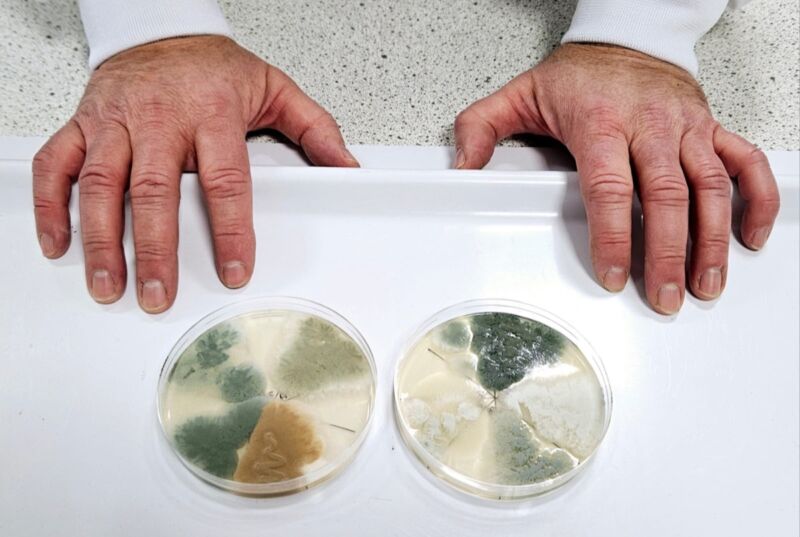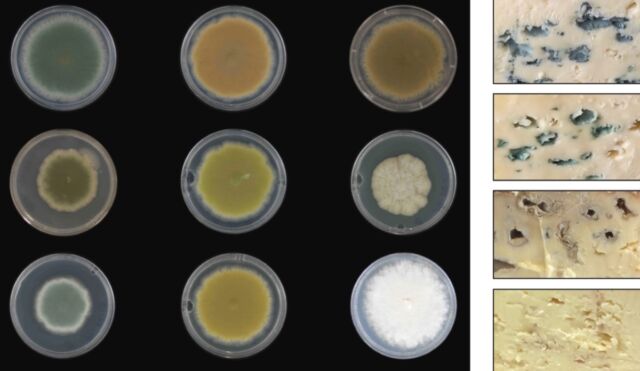
College of Nottingham
Gourmands are properly conscious of the numerous types of blue cheese, recognized by the blue-green veins that ripple via the cheese. Totally different sorts of blue cheese have distinctive taste profiles: they are often gentle or robust, candy or salty, for instance. Quickly we’d be capable to purchase blue cheeses that belie the title and sport veins of various colours: maybe yellow-green, reddish-brown-pink, or lighter/darker shades of blue, based on a recent paper printed within the journal Science of Meals.
“We’ve been keen on cheese fungi for over 10 years, and historically whenever you develop mould-ripened cheeses, you get blue cheeses reminiscent of Stilton, Roquefort, and Gorgonzola, which use fastened strains of fungi which can be blue-green in colour,” said co-author Paul Dyer of the College of Nottingham of this newest analysis. “We wished to see if we may develop new strains with new flavors and appearances.”
Blue cheese has been round for a really very long time. Legend has it {that a} younger boy left his bread and ewe’s milk cheese in a close-by cave to pursue a beautiful younger girl he’d noticed within the distance. Months later, he got here again to the cave and located it had molded into Roquefort. It is a fanciful story, however students suppose the fundamental thought is sound: individuals used to retailer cheeses in caves as a result of their temperature and moisture ranges have been particularly hospitable to innocent molds. That was bolstered by a 2021 analysis of paleofeces that discovered proof that Iron Age salt miners in Hallstatt (Austria) between 800 and 400 BCE have been already consuming blue cheese and quaffing beer.

The manufacturing course of for blue cheese is basically the identical as for any cheese, with just a few essential further steps. It requires cultivation of Penicillium roqueforti, a mould that thrives on publicity to oxygen. The P. roqueforti is added to the cheese, generally earlier than curds kind and generally blended in with curds after they kind. The cheese is then aged in a temperature-controlled atmosphere. Lactic acid micro organism set off the preliminary fermentation however finally die off, and the P. roqueforti take over as secondary fermenters. Piercing the curds kinds air tunnels within the cheese, and the mould grows alongside these surfaces to supply blue cheese’s signature veining.
As soon as scientists printed the whole genome for P. roqueforti, it opened up alternatives for learning this blue cheese fungus, per Dyer et al. Totally different strains “can have totally different colony cultures and textures, with industrial strains being bought partly on the premise of colour improvement,” they wrote. This coloration comes from pigments within the coatings of the spores that kind because the colony grows. Dyer and his co-authors got down to decide the genetic foundation of this pigment formation within the hopes of manufacturing altered strains with totally different spore coat colours.
The staff recognized a particular biochemical pathway, starting with a white colour that regularly goes from yellow-green, red-brown-pink, darkish brown, gentle blue, and in the end that iconic darkish blue-green. They used focused gene deletion to dam pigment biosynthesis genes at varied factors on this pathway. This altered the spore colour, offering a proof of precept with out adversely affecting the manufacturing of taste volatiles and ranges of secondary metabolites known as mycotoxins. (The latter are current in low sufficient concentrations in blue cheese in order to not be a well being danger for people, and the staff wished to make sure these concentrations remained low.)

College of Nottingham
Nonetheless, meals trade rules prohibit gene-deletion fungal strains for industrial cheese manufacturing. So Dyer et al. used UV mutagenesis—basically “inducing sexual copy within the fungus,” per Dyer—to supply non-GMO mutant strains of the fungi to create “blue” cheeses of various colours, with out rising mycotoxin ranges or impacting the risky compounds answerable for taste.
“The fascinating half was that when we went on to make some cheese, we then did some style trials with volunteers from throughout the broader college, and we discovered that when individuals have been attempting the lighter coloured strains they thought they tasted extra gentle,” said Dyer. “Whereas they thought the darker pressure had a extra intense taste. Equally, with the extra reddish-brown and a lightweight inexperienced one, individuals thought they’d a fruity, tangy factor to them—whereas, based on the lab devices, they have been very related in taste. This reveals that folks do understand style not solely from what they style but in addition by what they see.”
Dyer’s staff is hoping to work with native cheese makers in Nottingham and Scotland, establishing a by-product firm in hopes of commercializing the mutant strains. And there may very well be different modifications on the horizon. “Producers may virtually dial up their record of fascinating traits—roughly colour, sooner or slower development charge, acidity variations,” Donald Glover of the College of Queensland in Australia, who was not concerned within the analysis, told New Scientist.
Science of Meals, 2024. DOI: 10.1038/s41538-023-00244-9 (About DOIs).
